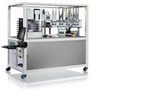Validating The Feasibility Of Using Stem Cells For Drug Discovery.

Menlo Park, CA - I-STEM is a new organisation formed by INSERM, the French national institute of health, with AFM, the French muscular dystrophy association, to validate the  feasibility of using human embryonic stem cells for therapeutics, both through cell therapy and in drug discovery. One goal of I-STEM is to establish a department of High Throughput Screening (HTS), able to speed up the process of discovery of new treatments against monogenic diseases using human embryonic stem cells. I-STEM aims to undertake, with its new automation systems, two to five high throughput screenings per year on embryonic stem cells, and thus increase significantly the number of potentially therapeutic molecules against its target diseases.
feasibility of using human embryonic stem cells for therapeutics, both through cell therapy and in drug discovery. One goal of I-STEM is to establish a department of High Throughput Screening (HTS), able to speed up the process of discovery of new treatments against monogenic diseases using human embryonic stem cells. I-STEM aims to undertake, with its new automation systems, two to five high throughput screenings per year on embryonic stem cells, and thus increase significantly the number of potentially therapeutic molecules against its target diseases.
Following an extended period of consultation, Velocity11 was selected to supply a flexible robotic platform to automate the stem cell culturing and screening processes. Velocity11 was chosen as the automation project partner by I-STEM because of its reputation in the pharmaceutical industry and the flexibility, operational speed and elegance of its proposed solution particularly in the area of contamination risk management. The system will mark the first time that stem cell culture and screening will be automated to this level of complexity in a 96-well microplate format and at this level of throughput.
Using a design based upon the powerful BioCel 1800 Automation System the I-STEM platform will use Velocity11's VWorks Automation Control software, an event driven controller, to manage protocols, and execute process runs. Liquid handling on the new I-STEM platform will be handled by two VPrep Pipetting Systems. The first VPrep System will use a 96LT pipetting head (volume range 2-200µl) and be dedicated to stem cell culturing. The second VPrep System will employ a 96 ST head (volume range 0.5-30µl) and be dedicated to compound management. The I-STEM platform will store and dispense microplates and tip racks using a compact VStack Automated Plate Stacker. The Velocity11 Lid Hotel* will be used to handle microplate lids. The Velocity11 Bar Code Label Print and Apply Station, VCode , will be used for plate tracking. A PlateLoc Thermal Plate Sealer has been integrated into the I-STEM platform in order to provide the capability to seal compound plates after each run.
A custom air filtration system was designed by Velocity11 in order to achieve I-STEM's stringent requirements for operational sterility. To avoid any risk of contamination the BioCel 1800 Automation System enclosure was equipped with a class100 ULPA filter. Four extraction funnels have been installed, one on each corner of the BioCel System deck. During the stem cell culturing and screening processes the filtered air will be re-circulated by the automation platform. A positive pressure will be applied in order to avoid any risk of contamination.
After automating the stem cell culture preparation and screening processes and validating the feasibility of using stem cells in drug discovery the main objective of I-STEM will be to create the French Centre for Stem Cell Research. The main focus of this new centre of excellence will be to undertake drug discovery research in the area of rare diseases; it will provide stem cell screening as a service to the pharmaceutical industry.
SOURCE: French national institute of health
